I. The Question of Work
Since the 1970s, a quiet cultural revolution has taken place that has restructured the desires of many people involved in art production, especially in relation to ideas of work and the working class. Increasingly, art production is distanced from the notion of work or the working life of wage earners. Who doesn’t want to earn a living performing leisure, for example? But the line is fine between such an attitude and the negation of value for what is performed by a majority of the population. Consider this conclusion to a text concerned with the increasingly difficult exercise of freedom in a world where even (or perhaps especially) idle chatter becomes symbolic capital:
As the artist who writes unpins and dislocates himself in discourse, he might elaborate scenarios that engage new possibilities of life. The scenario might serve as a concrete mode of subjectification, a means of auto-temporalization that could be taken up by others, folding back onto the work we do, not outside of discourse but pushing discourse to its own outside, producing breaks and flights within the discursive situation in such a way that work becomes a foreign activity.1
The last phrase (my emphasis) is emblematic of a growing distanciation of art production from the very idea of work, classically understood.2 It also raises the question of how and why we imagine foreign lands in relation to this work of distanciation (more on this soon).
In the face of the current tendency to understand work elsewhere, offshore, in another country, I’m tempted to bring up the case of Allan Sekula’s practice as a whole, and his 1974 photonovel, This Ain’t China, in particular. This is a work I came to know some ten years ago from books, which is probably why I think of it as a kind of strange fable for adults. And like any good fable, this one haunts me—especially when I try to think about reality and realism.
If, in this day and age, “reality” has become an almost impossibly unstable word—something that can only be invoked as an absolute construct, always relative, contingent, and virtual—this has taken its toll on realism (i.e., the critique of reality, which for so long took on the image of work as its emblem).3 For what follows, I would like to offer a simpler working definition of realism so as to carve out some space to consider the reality of work and the prescient evocation of distance from China in Sekula’s fable. It might sound dogmatic or Marxist or even Maoist, but I’ll have to take my chances: let us understand realism as the highlighting of contradictions that govern the world. So I’m working here, working on a hunch: the general avarice towards work in the art world forestalls any possibility of working through these contradictions. As a result, we may be stuck in a loop, enslaved to an idea of not working that all too quickly exhausts the real potential of art.
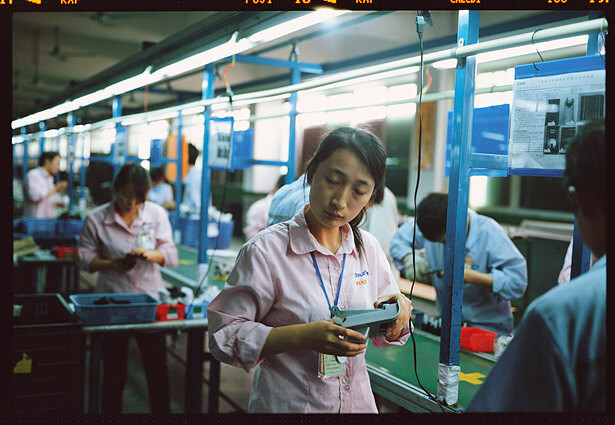

II. The Work in Question
This Ain’t China: A Photonovel consists of text, forty-one photographs grouped into nine frames, plus one framed diagram—a geometrically stable but theoretically absurd schema detailing restaurant labor-division and types of customer satisfaction.4 It was made around the time of the artist’s graduation from the fine arts department at the University of California–San Diego (UCSD), where Fred Lonidier taught and Martha Rosler was a fellow student. Lonidier was very interested in the intersection of aesthetic practice, labor activism, and his photographic work, which was often realized and displayed in spaces where labor unions gathered. Sekula’s This Ain’t China was also partly made in a working environment; namely, a fast-food restaurant where the artist was employed for a time, and where conditions were ripe for a strike. There are at least four different types of photographs that appear in the work: candid, black-and-white shots (of cooks at work in the restaurant kitchen and of all the employees goofing around outside); highly composed, full-color, “editorial” photographs (of pizza, hotdogs, burgers, blended fruit drinks, and so on); dimly-lit, contre-jour, budget noir shots (taken partly in some kind of executive office and partly outside a suburban house with a gleaming Cadillac out front—this crime convention is reserved for the boss’ environment); and, finally, staged, frontal black-and-white frames of the protagonists (the cook and the waitress, and also Sekula himself) deadpanning bold gestures to the camera in a style that evokes the Brechtian cinema of Jean-Luc Godard. In one shot, the three hold up a sign: CARNIGIE A-440/UNFAIR/TO LOCAL/JT. EX. BD. LOCALS/NO CONTRACT. In another, Sekula brandishes an AK-47 as his comrades stand firm, one pointing to his left, obscuring the portraits of Marx and Lenin on the wall behind them. There is a joy here (shared with Godard) in piling on the revolutionary clichés. The promise of these lying images is a higher truth.
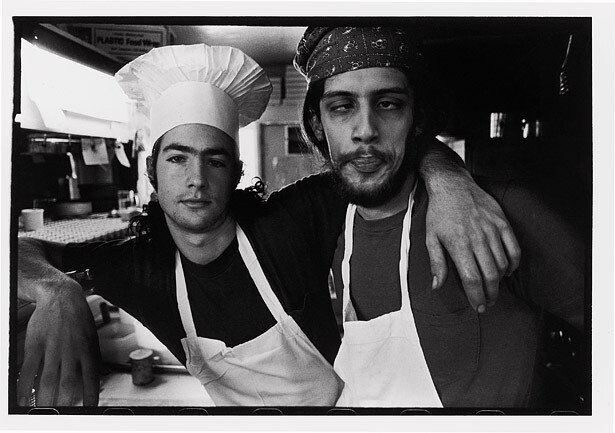

Alongside these images, there is a text in five short chapters—the first opens with the following disclaimer in bold, modern lower case: “the cook liked to believe that his story pivoted on a parable about the relative merits of fact and fiction in everyday class struggle.”
Much metanarration follows, as in: “everyone was satisfied that the first photograph constituted the truth and that the second was a clever piece of propaganda. and from that point on all the photos had a staged look. not because of a moral or aesthetic commitment to fiction but because it was no longer possible to photograph inside the boss’s kitchen nor was it possible to work there.”
But the photonovel also aims for psychological depth. The boss is not a one-dimensional dominator, but a man struggling to reconcile his strict scientific training with the glamour of art; he decides to access the joys of aesthetics through connoisseurship. He makes friends in high places and goes on to start several enterprises, of which the final one is a “restaurant that seeks a harmony between vivaldi and a staple food of the neapolitan working class. “cheese like carrara marble” was a slogan for his ads on the local classical music station.”
Each character starts as an archetype and evolves into a vehicle for channeling ideological complexes.
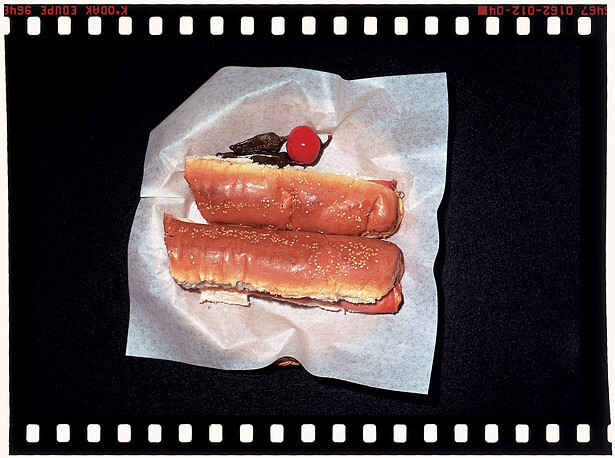

With the introduction of the waitress (who has also studied acting) comes a hilarious—because all too literal—primer on Brecht’s notion of the “culinary” in theater: “so this is what brecht meant by culinary opera she thought food and service designed to transport the customer into an imaginary world.”
Brecht resisted a theatre that absorbed his audience emotionally because he thought it too easily consumable to allow for critical response, instead developing his strategy of the Verfremdungseffekt (the audience’s sense of estrangement/alienation from the performers). It is this sense of a higher realism—not of images, but of the performers’ and audience’s complicity with their creation—that Sekula is after. The conscious effort required of the audience is less about dispelling falsehoods or resolving contradictions than about creating a kind of solidarity in the work of critical viewing.
As a Brechtian enterprise, This Ain’t China remains under perpetual construction, highlighting mixed motives and ideological confusion. And perhaps its least resolved aspect is the reference to China. After floating without much explanation over the tale of the cook, the boss, the waitress, the other workers, and their photographs, it is taken up in the third chapter. The key passage bears repeating in full:
some of the workers wondered what a brechtian restaurant would be one of the cooks had read a story in the los angeles times about the destruction of “fine chinese cookery” during the cultural revolution. the revolutionary cooks and waiters of peking had reorganized the restaurants to feed working people cheap and nutritious meals banishing the elevated fare that harked back to the rule of the feudal classes and which threatened to become a cultural bulwark of a new class of technocrats and managers. this cook was challenged by the others. this isn’t china they said we don’t serve elevated fare we serve pretentious fast food. the cook persisted. hadn’t they noticed the way well-off left-liberals behaved when dining in a restaurant? a waitress familiar with the university clientele agreed that there was indeed a difference between the intellectuals’ words and actions as though one could be a critic in thought alone. but no one was sure how to apply these insights to the present situation.
In the way that it is invoked, it remains unclear whether “china” is synonymous with the elevated fare beloved by the bourgeoisie (the use of all lower case in the main text helps us to think of “china” as a common, rather than a proper, noun; in other words, as porcelain); or if Sekula is mainly invoking the country that was then in the midst of the Great Proletarian Cultural Revolution, which lasted from 1966 to 1976 and which, as his fable reports, was achieving the satisfaction of working people so desperately missing from the tale unfolding before our eyes. So do the restaurant workers reading the Los Angeles Times not know how to—or do they not want to—identify with the Chinese proletariat? Like the cook, I think Sekula was curious about Maoism in those days, but unsure how to apply its insights to the American situation.
The ideological work of Sekula’s photonovel is to make the equation China = china strange. Indeed, negating china, with all its bourgeois associations, could mean affirming China, with its new proletarian revolutionary potential. If an equation inherited from the early days of colonial expansion when Europeans searched for the secret of producing the finest ceramics no longer holds, the bigger question that arises is one involving a tendency to project notions of production onto nations. An added twist comes when returning to this work between 2000 and 2010, for this is a period during which the Times is more likely to report how the PRC is rapidly becoming the world’s top capitalist producer, and quickly point out bad labor practices, the contradiction of Communist Party–led capitalist development, and a host of humanitarian infractions that would never happen here. Then again, to say “This Ain’t China” anywhere today is to close your eyes to the fact that many of the manufactured goods we encounter here are made in China. And this is just the beginning of the signifying spiral to be followed …
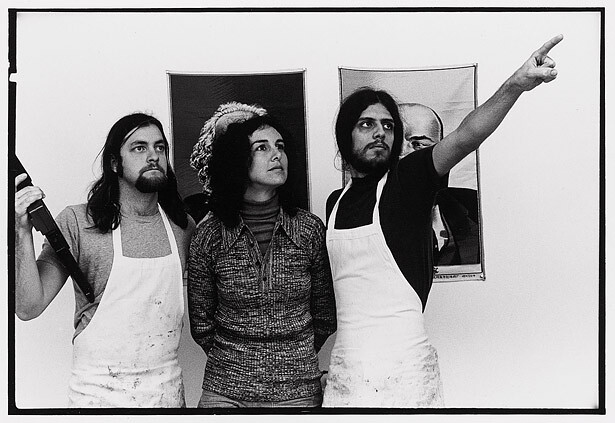

Sekula uses the convention (common also to Middle Eastern fables, which often begin with the phrase “There was and there was not …”) of oscillating between assertion and negation. The chapter subtitles achieve this most economically: “two / a psychological novel in which the boss invented himself and was in turn invented; three / a political novel in which workers were denied the privilege of psychological treatment; four / a political novel in which workers were allowed the privilege of psychological treatment; five / a psychological novel in which the boss invented the workers.”
He thus puts in place a play of contradiction that forestalls any notion of positive truth statements (in image or text). The photonovel begins with a negation of China, which puts pressure on every image and word that follows: what we see and read is not china/China. The fast food definitely ain’t china (lower case). But the artist also notes that he is not filming where he might want to (i.e., in the boss’ home) because it is impossible. Negation needs to be read (at least in part) as a form of desire. It is the key to dialectical thinking.
The title phrase asserts an oppositional attitude, one that speaks in the frank slang of the working class. Depending on how you read it, though, it could also uncomfortably approximate the attitude of a redneck Sinophobe. It can be infectious or repelling, or (since the aim is to highlight contradictions) both. Like a Brechtian play, it asks us to negotiate our distance to it rather than assume an empathetic stance. Certain questions remain wide open: Is the strike that is being discussed, even rehearsed, throughout this performative photonovel (the passage on China is followed by an elaborate list of grievances against the boss) meant to be our struggle, even as potential? Or is this kind of empathy anathema to the Brechtian schema of This Ain’t China, and much of Sekula’s work? My hunch (and part of my interest in showing the photonovel at e-flux’s exhibition space in New York’s Chinatown lies in needing to test this hunch) is that the work of this, perhaps Sekula’s most ideologically unresolved project, is far from accomplished. If the practice of conjuring and planning a strike brings us closer to the problems of workers, this proximity is also challenged by the fifth chapter’s sympathy with the boss, whose “employees did not understand business” and who “paid the same wages as everyone else in the area. he was not a rich man.” The lack of resolution comes to a boil in the last line, as the photonovel ends with the warning: “beware: a workers’ defeat has been converted into an artwork.”
But this cannot really be the last word, as the entire narrative has worked to foster a dialectical impulse, eliciting something to the effect of, “Oh no it ain’t!”5
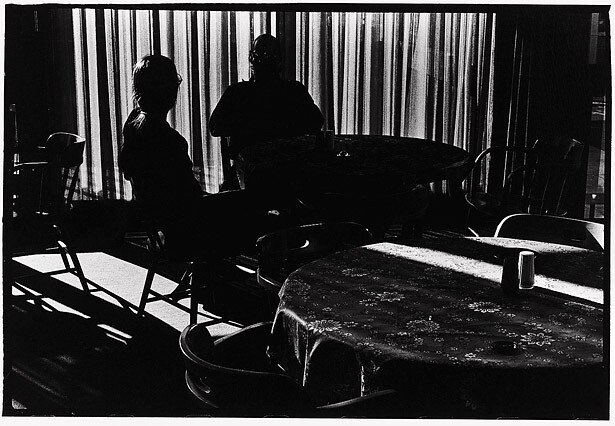

III. The Bigger Picture
At the time that This Ain’t China was made, an image of The Great Proletarian Cultural Revolution was making the rounds throughout the Western world, convincing many left-leaning artists and intellectuals to consider Maoism as a viable alternative to Soviet-style Marxism, which was being progressively discredited as Stalinist atrocities continued to come to light and Soviet tanks rolled into Prague in 1968. China’s support for North Vietnam also won it anti-imperialist credentials as the American position became increasingly untenable. In the late 1970s and 1980s, with the increasing availability of information about the famines of Chinese peasants, the humiliation of intellectuals, and the ruthlessness of the Red Guards, Maoism too was discredited. However, the international spread and mutation of Mao Zedong’s ideas—precisely in places that are not China, but also not the West—cannot be overlooked. It is impossible here to delve into such disparate phenomena as the protracted Naxalite struggle in the Indian state of Bengal or the Bolivarian Revolution in Venezuela (with its reverberations throughout Latin America); suffice to say that their successes—many on the symbolic front—continued to inspire the leftist political imagination in the West, even after people had become disaffected with regard to China proper. But I do not want to make too much of these cases, which are based mostly on agrarian reform. For in the late 1960s and early 1970s, what was particularly inspiring for the Western culturati about China’s proletarian revolution was that it prioritized culture as a site of struggle. Culminating in the protracted Sino-Soviet split, the Cultural Revolution also constituted a revolution within a revolution, promising a fresh start to those dissatisfied with the evolution of socialist imaginaries thus far.
The mystique of Mao Zedong (and Western Maoism’s potential influence on the events of May 1968) is signaled already in 1967 by Jean-Luc Godard’s La Chinoise, a film that features Claude Channes’ heady chanson “Mao Mao.”6 The student protagonists, undergoing a self-imposed period of reeducation and self-critique, all quote from Mao’s Little Red Book and debate correct thinking, contradiction, and the merits of violence in class struggle. This certainly ain’t China: most of the action takes place inside a big bourgeois flat in Paris and the conditions of the countryside—so valorized by Mao—are represented arch-ironically with glimpses of chickens running near the semi-industrial suburb of Nanterre, the site of early student unrest and rehearsal for May 1968. Yet Godard does present very concrete images and thus something we could call a Western Maoist cultural state-in-formation, which adopts China as the operative chimera. Godard would go on to form the Dziga Vertov Group with Pierre Gorin the next year. This was an experiment in collective production, which yielded some extraordinary experiments in film, and went on to tour the US in 1970 (a tour promoted by Grove Press).
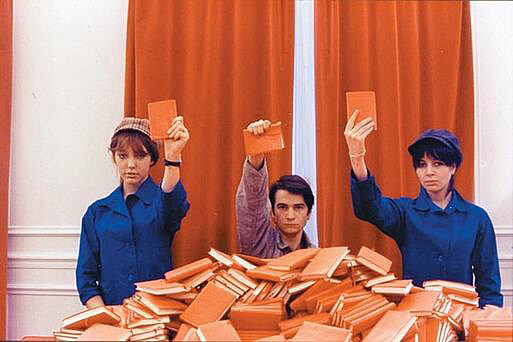

While Godard identified as a Maoist in those days, it is also crucial to invoke his relation to Brecht, whose aforementioned Verfremdungseffekt the French-Swiss director adapted for cinema—the strategy is used throughout La Chinoise, as each of the ultra-cool characters is interviewed by the director, speaking directly into the camera. Not only the breaking of the fourth wall, but also the cool demeanor of the actors recall Roland Barthes’ description of Brecht’s theatre as: “a phenomenon unknown in the West (perhaps precisely because Brecht had learned it from the East): a theatre without hysteria.”7 Thus, in invoking Brecht, we find further connections to China.
In Chinese Dreams: Pound, Brecht, Tel Quel, Eric Hayot crafts a compelling argument (supported by decades of scholarship) for rooting Brecht’s groundbreaking dramaturgical development in the director’s experience of Chinese theatre in Moscow, amidst Soviet theorists of estrangement like Viktor Shklovsky.8 Hayot’s entire book is remarkable in how it manages to trace the multiple but highly particular Chinas that have appeared in the West as ciphers of desired difference. Studying Tel Quel’s “Chinese Thought” issue, published in 1972, Hayot draws on the words of chief editor Phillipe Sollers in concluding: “Chinese Communist thought (and through it, most broadly, China itself) seems to be the resurgent repressed of global capitalism and imperialism.”9 In light of today’s oft-reported image of China in the West as a kind of nightmare of capitalist overdevelopment, Sollers’ image of China appears as a grand irony. However, the point here is that there is never one true China which operates as a foil to the West, but several, often contradictory ones.
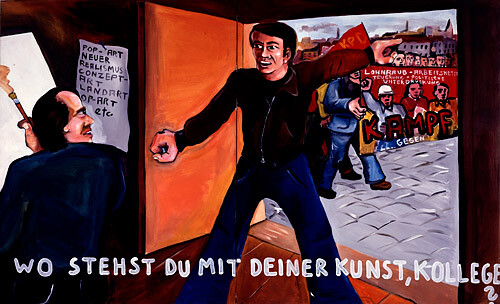

Hayot further situates Tel Quel’s dream of China in the context of the broader linguistic turn represented by the journal. Theirs was not the kind of instrumentalizing Orientalism that could more easily be ascribed to an author like Ezra Pound, who (ab)used the teachings of Confucius to develop his fascist ideology. Hayot observes in Tel Quel’s sustained attention to Maoist China, but also to ancient Chinese learning, during the early-to-mid 1970s, both a political interest in Maoism and something that activates a linguistic geopolitics: “at some point a certain group of people began to write about the world as though it were a text.”10 Hence (and this seems crucial): “China—the name alone—works not simply as a single vision of otherness, but as something like a Borgesian library, full of books with the same name but different texts.”11
We may be tempted here to consider This Ain’t China as one of these texts, a work of this transitional time for the global imaginary. As such, Sekula’s photonovel could be seen alongside Jörg Immendorff’s Maoist pictures, such as Komm runter, Kollege (Come Down, Colleague), Wo stehst du mit deiner Kunst, Kollege? (Where Do You Stand With Your Art, Colleague?) or Self-Portrait in the Studio, all painted in that strangely synchronous year of 1974.12 I see Immendorff working hard to reconcile his artistic career with the sweeping forces of social transformation. His cartoon-realist painting style is borrowed from the vernacular image of a heroic working class as seen in the emblems (pamphlets, woodcuts, and paintings) of the Chinese Revolution, which were circulating in Maoist bookshops throughout Europe and North America. And yet, even though he is perhaps the most committed Maoist of the German artists, his paintings are as much—if not more—about an individual’s struggle to reconcile the proletarian and the artistic life as they are part of the struggle to found a truly working class culture.13 If The Great Proletarian Cultural Revolution offered the promise of culture as the vanguard of revolutionary struggle, it cannot be emphasized enough that this alignment demanded the radical transformation of culture.
There are several more artworks, films, and texts from the 1970s that openly adopt Maoist vernaculars, and it would be difficult for me to enumerate them all here, not because there are so many, but because more work, more research has to be done on the subject. These works do not usually fit easily into the admittedly complex conceptual canon because they take up a form of visuality and a didactic relation to text that seems naïve, especially if when we see them we resist Brecht’s radical refusal to distinguish between didacticism and amusement.14
However, it is worth noting the work of Canadian artists Carole Condé and Karl Beveridge, because of the depth of their commitment to addressing the big questions of a working-class art. For over three decades, much of their collage/photo- and text-based work has been realized in collaboration with labor unions (many in the car factory town of Oshawa, Ontario), and depicts factory work and life and protest within a visual idiom that often gets dismissed as didactic or crass, but which actually attempts to fuse several important aesthetic lessons. As Allan Sekula recently wrote (of an exemplary project from 1987–1988):
Class Work, like almost all of their projects from the early 1980s onward, is a series of pictures combining studio staging with photomontage. That is to say, it deliberately fuses, or confuses, the space of the page and the space of the stage. This goes back, on one side, to the staging techniques of Erwin Piscator and Bertolt Brecht. On the other side it goes back to fewer of the photomontages of John Heartfield than one might expect.15
Sekula’s interest in Condé and Beveridge’s art dates back to the mid 1970s, when he met the couple while all were living in the culturally shell-shocked New York of the time, shortly before the two moved back to Canada. In the same text, he recalls a work called It’s Still Privileged Art (1976), which is described as:
a curious artifact: part confessional in the form of “criticism-self-criticism” as advocated if not actually practiced by a Maoist study group, part feminist consciousness-raising exercise, all presented in a graphic form derived from Chinese pamphlets of the Cultural Revolution period of 1966–1976: text block below the image, two-color printing with dramatically shifting red accents in a field of black-on-white line drawings and type.
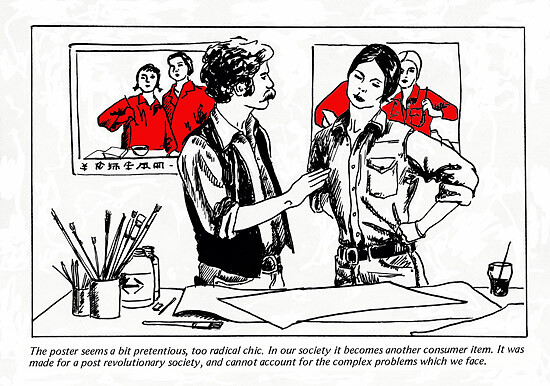

But for Sekula, the Maoist look of the work is perhaps not as important as the attempt to depict actual living conditions of workers and artists in solidarity within what he understands as everyday class struggle. As described, Class Work involves the depiction of fantasies of Chinese revolutionary life, but these are also rendered as questionable amidst the realities of competition in courting collectors and more general worries about the compatibility of social commitment and artistic practice.
Notable for me is Sekula’s observation of a triple negation operative in Condé and Beveridge’s work: “of minimalism, of competitive individual authorship in favor of a conjugal collective of two, and of New York as the center of advanced visual art.”16 The big question that arises here is how art, and especially the kind of art that refuses the negation of work, itself proceeds through a negation that multiplies itself. Sekula’s “this ain’t china”—the phrase alone—should be seen as this kind of multiplying negation. And in this, Sekula departs from Maoist lessons, or at least misreads them productively.
Despite his great emphasis on contradiction (mostly among classes) as an undeniable social fact that necessitates violent revolution, Mao was not a deep dialectician. Slavoj Žižek notes that, in refusing to borrow the notion of a “negation of negation” from Engels’ dialectics, Mao committed a great folly, which ultimately led to a return of the repressed: the realization of the most unimpeded capitalism, inside communist China.17 It is only in negating communism as a negation of capitalism (but then this may have implicated and challenged Mao’s own rule), that something new could have been imagined. This observation goes some way toward explaining the ultimate ambivalence about Maoism signaled in This Ain’t China, and also amidst many artists looking for a way to work on the problems that Maoism identified but failed to solve.
IV. More Work
As Sekula’s practice has developed over the years, he has continued to address the problems of aligning his own artistic practice with the general conditions of workers under global capitalism, and in opposition to art’s tendency to look the other way. What is notably consistent in his practice is a simultaneous navigation of actual and imaginary geographies. In Fish Story and the many works that spin off this study of ports and shipping, the world’s seas and oceans serve both as the concrete support of trade and as an oceanic allegory of struggle against seemingly insurmountable natural forces—especially the one great leviathan of a force that has been covered up as a product of social will because people continue to be convinced that it is the natural state of things: capitalism. The more recent Polonia and Other Fables (2009), photographed inside and outside of Poland (in Chicago), commences with a total dislocation, borrowed from Alfred Jarry, whose spoken preface to the presentation of Ubu Roi at the Théâtre de l’Oeuvre in Paris on December 10, 1896, ends with this note: “As to the action which is about to begin, it takes place in Poland, that is to say, nowhere.”18 Another explosive negation.
This first line reminds me of another—the last spoken in Roman Polanski’s noir thriller Chinatown, which was also made in 1974. And though I do not want to belabor the comparison, we could say that Polanski’s fable is structurally related to Sekula’s in that the title (and its geographic subject, Chinatown itself) gets very little play except for one crucial moment. At the very end of the film, after private detective Jake Gittes finally unravels a hidden web of murder, incest, and waste (of thousands of gallons of water during a major draught in the Los Angeles area), he is left damaged and demoralized, but inclined to make one last gesture that might bring all this to light in a more profound way. It is here that his partner turns to him and says: “Forget it, Jake, it’s Chinatown.” The credits roll, but the negative mystification of Chinatown as the site of all the repressed crimes of Los Angeles has just begun.
Writing all this ahead of an exhibition at the e-flux exhibition space in New York’s Chinatown, which will feature Allan Sekula’s This Ain’t China: A Photonovel, I realize that this is an opportunity to see some of these disparate fantasies of China, china, and Chinatown working together, perhaps working in such a way that will also say a lot about how work itself is configured in relation to artistic activity. And I will admit to a level of deep discomfort—the feeling that tends to signal to me that conditions are ripe for a lesson in aesthetics.
One new work presents a particular problem. It is a backlit transparency that will face the street, showing a young Chinese woman in a brightly lit appliance factory, holding a machine part she is helping to manufacture, her eyes closed. I learned that the photograph was taken outside of Guangzhou (a space of exception that—as one of China’s special economic zones—both is and is not China) while Sekula was conducting research for a documentary about working conditions in some of the world’s busiest ports entitled The Forgotten Space (forthcoming). I wonder if he arrived at this title having heard one too many times, “Forget it, Allan, no one wants to see pictures of real workers … Besides, aren’t you exploiting these people by taking and showing their pictures?” The problem here lies in the subject relations between artist and worker. These relations seem governed by a radical non-alignment between the artist’s ability to see and record and the worker’s proverbial blindness—not to mention the race and gender differences. If “wrongs” pile up in Sekula’s picture—add to the seemingly unequal subject relations, the fact that we generally reject photos with red eyes or closed eyes—confronting such an image in monumental, back-lit intensity converts the unsightly into an act of artistic intention. Thus Sekula’s work begs the question, “What else is wrong with this picture?”
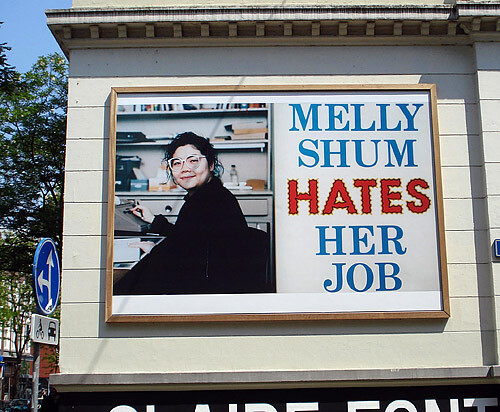

The work of/with negation, which I think is crucial to artistic practice, continues to adapt in Sekula’s work. His strategy is not only to challenge viewers with images of workers and work—thereby negating the denial of workers as valid subjects of aesthetics—but also to bring about a confrontation with those images that form when we close our eyes, forget what we can see, and give ourselves over to the imagination.19 When I do this, Ken Lum’s Melly Shum Hates Her Job of 1990 comes to mind—an image I greet each day I go to work (at Witte de With). If Melly’s closed-mouth smile partly contradicts the closed eyes of Sekula’s photograph, they both assert the strange constant of the Chinese worker as a kind of emblem of the idea of work as a foreign activity. How to show more of this kind of collective dream while also denying it?
Especially because of her calmly closed eyes, the Chinese woman in Eyes Closed Assembly Line (2010) looks almost angelic, and thereby tends to transcend her surroundings even as she responds directly to them. Sekula’s camera has caught a moment that allows for the brightness of the transparency and the brightness of the fluorescent lights in the factory to work in concert. This strong relation between image and support is aesthetically pleasing. But the woman’s closed eyes are an irritation to visual pleasure. And she looks a bit tired and defeated, which returns me to the last line of Sekula’s This Ain’t China: “beware: a workers’ defeat has been converted into an artwork.” Here I realize that this phrase needs work.
Perhaps it should be: “beware the artwork defeated by the thought that art and work, artists and workers, are foreigners.” Perhaps we could consider the Chinese woman with her eyes closed as a comrade: daydreaming of another cultural revolution. On this rare occasion when Sekula presents us with one, very silent image (usually text and other images aid the work of negation), perhaps what comes to the fore as a result is the artist’s commitment to developing an aesthetic relation to working life.
John Kelsey, “Escape from Discussion Island” in Meaning Liam Gillick, ed. Monika Szewczyk et al. (Boston, MA: The MIT Press, 2009), 69. Kelsey is a writer, an artist, and one of the agents behind the discursive life form that is Reena Spaulings, as well as the New York–based independent organization, Bernadette Corporation. In creating a virtual life and in running a corporation with anti-corporate claims, he embodies a Deleuzian and Situationist attitude, distinguished by attempts to free up time. That this existence appears to embrace commercial activity (for instance, Bernadette Corporation is active as a commercial gallery in a Lower East Side space and at art fairs), makes it an emblem of sorts of what I observe to be contemporary critical attitudes of (strategic?) affirmation with respect to the capitalist system that such activity nonetheless purports to critique. Liam Gillick (the deliberately unnamed subject of Kelsey’s essay) is another interesting case in point, as much of his artistic activity in the past five years has centered around an evolving scenario of a car factory, where workers are left to imagine an existence outside of Fordist notions of work on a production line, for hourly wages. The scenario itself contrives to enact an infinite deferral of the replacement of this space of limbo with measurable production. As I edited Kelsey’s essay it made me consider to what extent Gillick’s discursive practice is an attempt to align art (which is increasingly seen in galleries established in disused factories) with the reality of factory work.
Of course, this is not new; we could recall on the one hand the whole tradition of dandyism (exemplified by artists like Marcel Duchamp and Andy Warhol); on the other, Hannah Arendt’s low estimation of work in her division of the fundamental human activities into labor, work, and action.
Here I am thinking of the honored nineteenth-century realist tradition—especially the work of painters like Gustave Courbet, or later painters like Robert Koehler, Winslow Homer, Ford Madox-Brown, and the sculptor Constantin Meunier, the latter two being of particular inspiration for Sekula, as has been discussed by the art historian Hilde van Gelder in several texts, amongst them, “Allan Sekula: The Documenta 12 Project (and Beyond),” A Prior 15 (Summer 2007). We could also think of socialist realism, which produces a fiction of happy workers—a highly stigmatized form of representation because it was favored by Stalin and Mao, each of whom failed to make this fiction a reality.
It is reprinted from James H. Westbrook’s Your Future in Restaurants and Food Services (New York: Arco, 1971).
Tempted to single out the photonovel’s provocative last phrase in the press release, I receive the following note from Allan: “As for the quotes, I think it should be reduced to the ‘truth and fiction in class struggle.’ We can leave defeat out of it. When Zhou En Lai was asked his opinion of the French Revolution, he replied ‘it is too soon to tell.’”
If you’re reading this online, have a look: →. Some of the lyrics are (perhaps badly) translated as: “Vietnam burns and me I spurn Mao Mao / Johnson giggles and me I wiggle Mao Mao / Napalm runs and me I gun Mao Mao / Cities die and me I cry Mao Mao …” In 1972, Andy Warhol made a print of the Chinese chairman, as the most famous man of the year.
Roland Barthes, The Rustle of Language, trans. Richard Howard (New York: Hill and Wang, 1986), 157.
See Eric Hayot, Chinese Dreams: Pound, Brecht, Tel Quel (Ann Arbor: The University of Michigan Press, 2006), 75–88. The quote from Barthes is taken from Hayot’s chapter on Brecht (102). In a section titled “Alienation and Estrangement,” Hayot explains a distinction between Verfremdung (alienation) and Befremdung (strangeness) and argues against the fusion (by scholars such as Renata Berg-Pan, in her 1979 study Bertolt Brecht and China) of feelings of strangeness (simply experiencing a different culture) with the feeling of alienation. For Brecht, then, alienation (which denies empathy and prevents misinterpretations of the truth mechanisms of theatre) must be produced both by actors and audience. Hayot argues that Brecht’s consistent study of Chinese theater and poetry sharpens his critique of authenticity, and in turn refuses the projection of an “authentic” China.
Hayot, 121. Sollers characterized the Cultural Revolution as “the battle of a long-repressed thought, of mass revolutionary practice now consolidated in the light of day” (cited in Hayot, 118–119). This emphasis on China as the repressed of the West is also traced in Julia Kristeva’s contributions to the same issue.
Hayot, 123.
Hayot, 125.
This is the same year that the entire Tel Quel group, including Roland Barthes, went to China. Hayot’s chapter on the journal opens with a lengthy quote, which we will find out is from Julia Kristeva’s Des Chinoises (Of Chinese Women). Immendorff’s Komm runter is likely a nod to Mao’s call to urban intellectuals to come down to the countryside for reeducation.
The online press release of a recent exhibition of his works from the period at the Michael Werner Gallery in New York (October 9–December 19, 2009) recalls: “In 1970 Jörg Immendorff joined the League Against Imperialism, pledging henceforth to direct his creative endeavors to the service of the German Maoist party. Disillusioned by the outcome of European political events of the late nineteen sixties, and increasingly dissatisfied with his role as an artist, Immendorff sought to produce paintings for and about the working masses.”
On this point, see Hayot, 60.
Allan Sekula, “…The Red Guards Come and Go, Talking of Michelangelo,” in Carole Condé and Karl Beveridge: Class Works, ed. Bruce Barber (Halifax: Press of the Nova Scotia College of Art and Design, 2008), 45–50. In this text, Sekula cites examples from the Canadian press, especially the writing of the influential conservative critic John Bentley Mays, to illustrate the dismissive tone that has tended to obscure serious attention to Condé and Beveridge’s work. As a student, I spent quite some time with these images while doing conservation and archival work at the Morris and Helen Belkin Art Gallery, on the campus of the University of British Columbia, which has an important collection of Condé and Beveridge’s work; and though I cannot say I have resolved my misgivings about Condé and Beveridge’s didactic aesthetics, they did make me laugh. And this in turn always called up for me Brecht’s anti-romantic dictum: “spasms of the diaphragm generally offer better chances for thought than spasms of the soul.” See Walter Benjamin, “The Author as Producer,” in Understanding Brecht, trans. Anna Bostock (London and New York: Verso, 1998), 100.
Sekula, “The Red Guards,” 49.
See Slavoj Žižek, “Introduction: Mao Tse-Tung: The Marxist Lord of Misrule,” in Mao: On Practice and Contradiction (London and New York: Verso, 2007), 11–21 (especially).
Alfred Jarry, “Preface” to Ubu Roi, trans. Beverly Keith and Gershon Legman (Mineola, NY: Dover Press, 2003), 3. On page 9 of this Dover edition, the play’s title is Ubu Roi or The Poles. It should be noted that on the date Jarry spoke his preface Poland was still partitioned and therefore had no sovereign territory, was indeed nowhere. Sekula’s new series weaves images of and text from the Polish community in Chicago with furtive shots inside Poland of the outskirts of areas rendered inaccessible because of secret US military activities, purportedly the transport and torture of unlawful combatants. The quote from Ubu Roi was reproduced in vinyl on the wall of the Zacheta Gallery in Warsaw, where Polonia and Other Fables is installed for Sekula’s eponymous survey, curated for this venue by Karolina Lewandowska.
As such, he also ventures to reform his own approach. I am reminded of an image from This Ain’t China, of the cook with his eyes almost insanely crossed. Here, the motif of “incorrect vision” already surfaces, but the particular, performative heroism of many of the photographs in This Ain’t China is not operating in the new transparency. The image departs from the Brechtian complicity of subject, camera, and audience present in Godard’s films and Sekula’s earlier photography. Sekula’s interest in “performance under working conditions” (to paraphrase the title of his Generali Foundation retrospective and the title of an early, never-exhibited video) remains.

